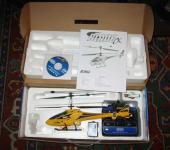
| Electric-RC-Helicopter.com --- Forum |
 |
||
|
| Profile |
|
Welcome to Electric Rc Helicopter Forums, Guest.
Register |
| Information |
|
Our users have posted a total of 33454 articles We have 9305 registered users The newest registered user is Daniel Gillespie |
| Who is Online |
| 20 Guests |

|
Within a reasonable driving distance from my house, there are four well-equipped hobby shops. When I started this review some time ago, each of them had ordered E-flite’s Blade CX helicopters and not one of them had one still in stock. Sold out in no time! Doesn’t that tell you something? Fortunately, the initial rush to be a Blade CX owner has abated -- or at least Horizon is keeping up with stock quantities! -- and there will likely be one waiting for you at your LHS.
 As far as I am concerned, the Blade CX Coaxial Helicopter is a tiny miracle. I have 70 year old reflexes, only average skills when it comes to piloting fixed wing RC aircraft, an unwillingness to put up with the expense and complexity of the RC helicopters that have been on the market for the last several years, and, being a Mac user, no possibility of practicing with a flight simulator. Some time ago, when the helicopter bug bit me, I asked the famous Red, proprietor of Red’s Hangar One Hobbies in Rohnert Park, CA, (we have a Sherlock Holmes-Dr.Watson relationship) when there was going to be a helicopter suitable for my modest capacities. His answer was “next week.”
As far as I am concerned, the Blade CX Coaxial Helicopter is a tiny miracle. I have 70 year old reflexes, only average skills when it comes to piloting fixed wing RC aircraft, an unwillingness to put up with the expense and complexity of the RC helicopters that have been on the market for the last several years, and, being a Mac user, no possibility of practicing with a flight simulator. Some time ago, when the helicopter bug bit me, I asked the famous Red, proprietor of Red’s Hangar One Hobbies in Rohnert Park, CA, (we have a Sherlock Holmes-Dr.Watson relationship) when there was going to be a helicopter suitable for my modest capacities. His answer was “next week.”
When I arrived the following week, there was an elegant, bright yellow copter sitting on top of its cardboard case on a display counter. Red walked over, transmitter in hand, connected the battery and proceeded to fly the little Blade up and down the aisles of his crowded shop. Then he placed the Blade in a hover, stepped back, placed the transmitter on the floor, and walked away, leaving the copter to hover unassisted. Finally, after a few pirouettes, he landed the little craft on top of its cardboard box. You think I exaggerate? Take a look at the attached video in which Red recreates his wordless sales talk. No wonder dealers can’t keep these in stock!
Not only is this beast exactly what I had been longing for, the price and quality are amazing. For less than $200, you get a "take it out of the box, charge the battery, and fly" helicopter. Nothing to build. No endless adjusting and balancing. Nothing to buy except for 8 AA batteries for the transmitter. And it is rugged.
 The Blade CX cuddled in Styrofoam trays inside an attractive cardboard box. The well designed box with a plastic handle serves as a carrying case for the copter, transmitter, and accessories, including, if you acquire them, space for spare parts. Even King Kong posing as a postman couldn’t damage the contents.
The Blade CX cuddled in Styrofoam trays inside an attractive cardboard box. The well designed box with a plastic handle serves as a carrying case for the copter, transmitter, and accessories, including, if you acquire them, space for spare parts. Even King Kong posing as a postman couldn’t damage the contents.
Contents:
There is also a 36 page instruction manual which every manufacturer should strive to emulate. It is the most clearly written, complete, and error free manual I have ever seen. Congratulations to the copywriter! Finally, there is a DVD (which won’t play on a Mac – one of my very few complaints) which shows what to expect of the CX.
Assembly? There isn’t any. Of course you've already read the entire manual before beginning "assembly". In case you haven't, while your battery is charging, you should look at page 11 of the instructions and make sure your Blade balances as it should. Then if you are unfamiliar with helicopters, you can start at page 21 and read how the controls work and how to trim the copter. Then, with a charged battery installed, go to page 12 and test the controls as explained there. OK. Now you are good to go.
An optional training gear (EFLH1205) is available. I was willing to get one, but Red suggested I could get along without it, so I took his advice.
There is an optional AC transformer for the battery charger(ELFC4000). This will save you from running out to connect to your car or from having to lug a compact 12 volt battery around. I think it is a worthwhile investment.
I recommend having a few spare parts on hand:
These parts will take care of the most likely victims of training accidents.
 The Blade CX is designed to be extra user friendly and extra stable. Want to lift off and fly around your living room? This is the machine for you (but learn in a larger space, first).
The Blade CX is designed to be extra user friendly and extra stable. Want to lift off and fly around your living room? This is the machine for you (but learn in a larger space, first).
Is your Blade CX doing something weird? Let go of the sticks and it will fly itself back to stability. That’s what a beginner wants, what a beginner needs, and what a beginner gets.
The trade off, of course, is that loops, inverted flight, and other aerobatics must await your next helicopter.
Red indicates, "To a seasoned helicopter pilot, the Blade CX will feel quite abnormal because it is so positively stable. Instead of continually catching it as it veers away from stability, as is the case with conventional helicopters, you need to push it where you want it to go with deliberate control inputs and it then goes right along willingly. It is by far the easiest copter I have ever flown and is the first I would recommend without reservation to a complete beginner."
From the photos and video, you can see what an experienced pilot can do with the CX, so ... how did yours truly, old fumble fingers, do?
Well, for a guy like me there is a learning curve involved. The fact that from the beginning I was trying to learn to fly indoors in a cramped space with a low ceiling didn’t help matters. It took two flights a day for over a week before I had hovering and basic movements down pat. During that time I did chip and replace a couple of blades, but that’s all. On the whole the CX survived my “learning events” unblemished. I bet this stage will take most new owners considerably less time than it took me, and now I am at the point where the CX is my little friend.
Early in the morning when the air is still calm, I take out my heli and fly it as I stroll up my long driveway to go fetch the morning paper, tuck the paper under my belt, and fly the copter back down the drive, through my garage, and park it on my workbench. And what a joy it has been to be able to fly something indoors on stormy days. Once you get the hang of it, this little beast can be flown with great precision.
First of all, E-flite recommends that you make your first flights indoors in space at least 20 by 20 feet and with a high ceiling. I didn’t have a space like that available, and the lack of one slowed my learning curve drastically. In your house in a typcial room, the rotor wash from those contrarotating blades will bounce off the walls and off furniture and buffet your helicopter all over the place.
The Blade CX is very sensitive to even the slightest breeze. That’s why you don’t want to fly outdoors at first. Even indoors, drafts from open windows, a heating duct, or even your dog scratching fleas will destabilize the copter. In the beginning, stick to still air.
Just as soon as possible, get your helicopter up to the level of your belt. Below this altitude, the helicopter is bounced around by the wash from its rotors; above it, things smooth out.
Try not to over control. This copter pretty much wants to stay in a stable hovering position. Once it is trimmed, if you want it to do something else, you have to make it do what you want.
If the helicopter is doing something you don’t want – moving to the left, for example, so you have to keep holding the right hand stick to the right – set it down and “click” in some left trim, then take her up again. Trim only one control at a time. Repeat until your helicopter holds a hover.
Many people find that if they fly for about a minute, set down, unplug and replug the battery, and then take off, the helicopter is in much better trim. This apparently resets the electronics in the little black box to compensate for the helicopter’s warmed up condition.
At this point, most of you will be flying just fine, but some of you, like me, will find the going a little slow. What to do? Do what Olympic atheletes do. Visualize!! No kidding. I know about this stuff and it works. Sit in a comfortable chair with your transmitter in your hands. Close your eyes. Move the left stick (throttle) forward. “See” the helicopter rise in the screen of your imagination. Pull the stick back. “Watch” the helicopter settle. Repeat a few times. Now let the helicopter rise and try another control. Watch the helicopter move. Try the controls one by one, all in your mind’s eye, and then try using them in combination, as for instance, left stick forward to rise plus right stick forward to move forward, plus left stick to the right to point the nose to the right, and so forth. It works at the Olympics, and it’s going to work for you.
Finally, to seek advice, help, or other information about flying, hopping up, repairs, and other modifications, or just to see what other CX flyers are up to, log on to the to the Multi Rotor Helis discussion thread at RCGroups.Com. There are literally hundreds of messages about this one helicopter.
Credit: rcgroups.com
http://www.rcgroups.com/forums
/showthread.php?t=508079
Wahrftig ( Albert Wahrhaftig )
|
Comments: |
| Comment form closed due to spams. Please use the forum to post comments instead. |
| HOME PAGE |
| FORUM |
| Articles |
| Product Review |
| Sim / Training |
| Forum |
| Album |
| Links |
Product Review |
||
- |
(c) 2007-2011 Electric-Rc-Helicopter.com